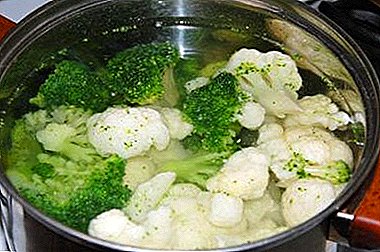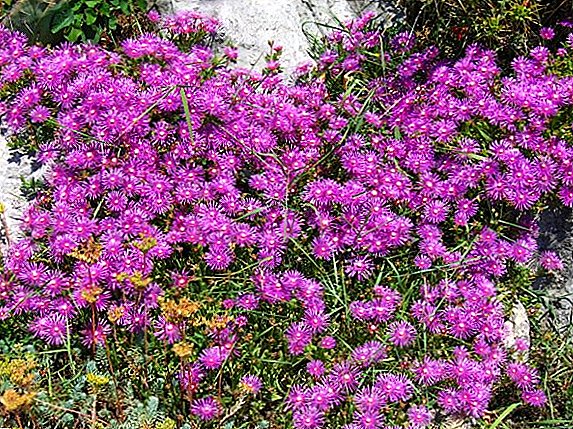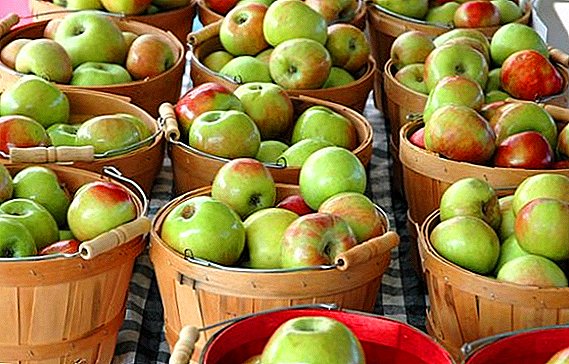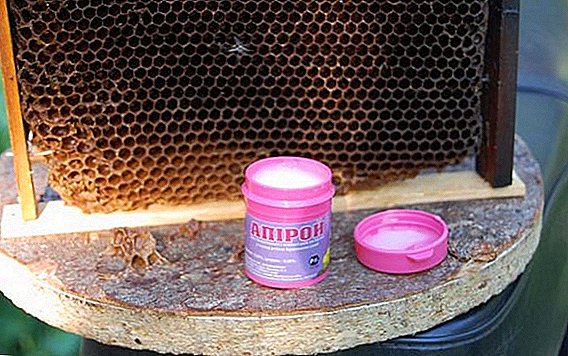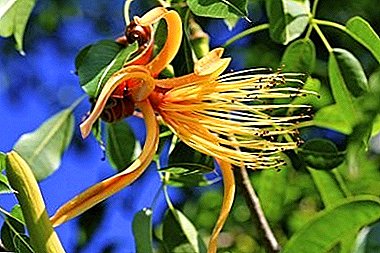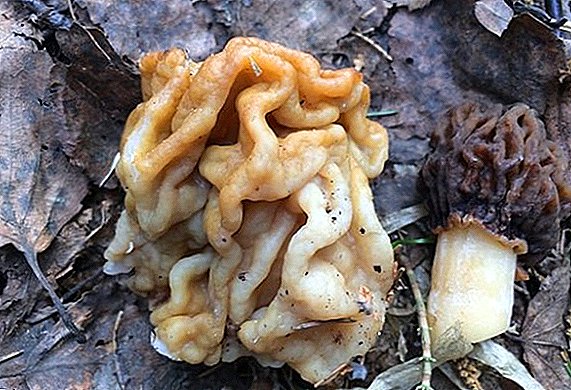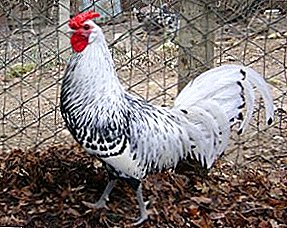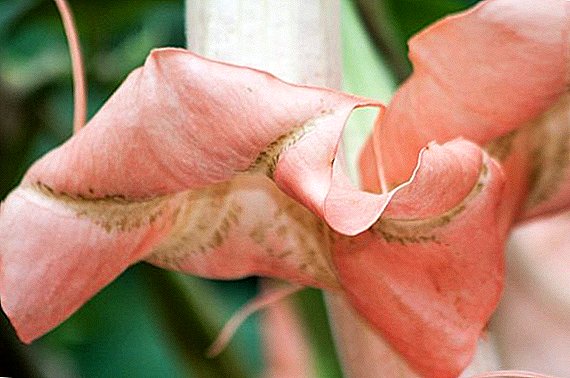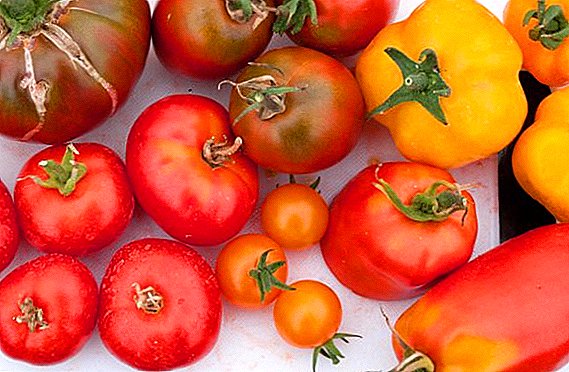 Varieties of tomatoes, bred in Holland, not the first year in demand from gardeners.
Varieties of tomatoes, bred in Holland, not the first year in demand from gardeners.
This culture is used both for raw consumption, without any heat treatment, and for preservation and preparation of many dishes. Popular tomato is certainly not deprived.
Therefore, many people prefer to grow the plant at home, to be sure that the fruits do not contain anything extra.
Today we will understand what is the difference between a Dutch tomato, how he conquered gardeners, what features and advantages he has, and also consider some of the varieties.
Features
For the first time, a tomato appeared on the tables of Europe in the 18th century, and since then it has been used in the preparation of various dishes - from soups, salads and main dishes to desserts.
Did you know? Two previous centuries, this plant did not belong to edible, because the climate of many countries did not differ by warm weather, the tomato simply did not have time to ripen. Therefore planted it for decorative purposes. The taste of tomatoes opened to the world the Italians - began to use the fruit pulp in the preparation of salads. They also contributed to the appearance of the word "tomato", although initially the plant was called nothing other than "tomato".
Tomato, as you know, is a thermophilic plant, the climate is demanding. All the more surprising that this culture was able to settle down perfectly in the expanses of Holland. This country is not famous for a large number of sunny, warm days a year, there is also a lot of rainfall there, however, the Netherlands is today considered to be one of the best suppliers of tomato seeds in the world.  Dutch breeders tried their best and brought out a hybrid of tomatoes that would adapt to their climate and give a good harvest. Dutch varieties of tomatoes are suitable for growing both in greenhouses and in a familiar garden bed.
Dutch breeders tried their best and brought out a hybrid of tomatoes that would adapt to their climate and give a good harvest. Dutch varieties of tomatoes are suitable for growing both in greenhouses and in a familiar garden bed.
However, not all of them are designed for both outdoor and greenhouse conditions. Therefore, it is necessary to pay attention to the label and examine the information about the variety you have chosen in order to be able to provide him with the right care and find the most suitable option for you.
Among the characteristics of the tomato you can find any - from the time of its ripening, the size of the bush and fruit, yield to describe the taste.
Important! In areas with a cold climate, preference is given to growing crops in a greenhouse, even if the label indicates that the variety is suitable for planting in open ground. Do not forget that the tomato tolerates low temperatures poorly, and the mistake made by the gardener can negatively affect both the growth of the bush and its productivity.
 Dutch tomatoes are famous not only for their resistance to cloudy weather, but also for their transportability - they manage to maintain an attractive appearance after transportation, which is important for people who subsequently sell these tomatoes. In addition, the plant has a high resistance to various diseases, which makes it even more popular.
Dutch tomatoes are famous not only for their resistance to cloudy weather, but also for their transportability - they manage to maintain an attractive appearance after transportation, which is important for people who subsequently sell these tomatoes. In addition, the plant has a high resistance to various diseases, which makes it even more popular.Early Dutch
Such tomatoes are attractive to gardeners so that the harvest can be quite quickly compared with other species. For ripening the fruit will need a little more than 3 months - the countdown starts from the days when the tomatoes grow on the bed.
One of the most famous early ripe varieties of Dutch tomatoes is considered Big Beef F1. Its distinguishing feature is the size of the fruit. Their minimum weight, which you can observe, will be 200 g, and as a rule, more. Tomatoes grow in the shape of a ball, have a bright red color, as well as a pleasant taste. This tomato is used most often for making salads. Fruiting begins soon enough - after 100 days from the day of germination of seeds.  Another positive characteristic is high resistance to diseases, among which are tobacco mosaic, nematode, gray spot, stem cancer and fusarium wilt. Yield pleasantly surprised: from 1 square. m you can get up to 15 kg of fruit, if you place on this site no more than 3 bushes.
Another positive characteristic is high resistance to diseases, among which are tobacco mosaic, nematode, gray spot, stem cancer and fusarium wilt. Yield pleasantly surprised: from 1 square. m you can get up to 15 kg of fruit, if you place on this site no more than 3 bushes.
True, there will be no care, which should not be overlooked if you want to get the maximum yield. The plant will require pasynkovanie, and the best way to grow a healthy, strong plant is growing in one stem.
Important! Shrubs of this variety must be tied to the trellis so that the plant stems do not break under the weight of the fruit. And the trellis itself will have to be placed at a height of about 2 m, and sometimes higher.
From the F1 series, it is still possible to distinguish such early-maturing varieties as “Crystal”, “Tarpan”, “Bobcat” and “President II”.  Early varieties are good for fresh consumption, but experienced gardeners prefer not to give a lot of land for the cultivation of only early tomatoes.
Early varieties are good for fresh consumption, but experienced gardeners prefer not to give a lot of land for the cultivation of only early tomatoes.
Medium grades
It is impossible not to note their versatility: these varieties are not only suitable for fresh consumption, but also perfectly suitable for preservation. Their cultivation accounts for the largest part of the site. Consider some varieties of medium ripening.
"Torbay F1"
This variety survives well in the open field, but at the time of cold weather it is still necessary to hide it under the film. Ripened tomatoes reach a weight of 200 g and more, in shape resemble a slightly flattened ball, and ribbing is inherent in the fruit. “Torbay” gives a good harvest, and its taste is pleasantly surprising and in no way inferior to already proven varieties. One more important quality can be added to the list of advantages: this variety, due to its dense structure, makes it possible to transport a tomato without any special difficulties and not to worry about its appearance.
“Torbay” gives a good harvest, and its taste is pleasantly surprising and in no way inferior to already proven varieties. One more important quality can be added to the list of advantages: this variety, due to its dense structure, makes it possible to transport a tomato without any special difficulties and not to worry about its appearance.
It is possible to attribute the fact that it will be necessary to tie up and shape it, despite the fact that the height of the bush barely reaches 1 m, to the peculiarities of care for a tomato. Above it it will not grow.
"Bomax F1"
The fruits of this variety are also rather big - weighing about 200 g. This tomato attracts attention not only in size, but in glossy, red skin. Just like other varieties, "Bomaks" tolerates transportation, and it does not affect its appearance. In addition, the fruit can be stored fresh, without any heat treatment for a long time - about a month.  "Bomaks" refers to those varieties of Dutch tomatoes, which are designed for open ground, that is, they can be grown straight in the garden, and it also needs to form a bush.
"Bomaks" refers to those varieties of Dutch tomatoes, which are designed for open ground, that is, they can be grown straight in the garden, and it also needs to form a bush.
In addition to these, varieties under the names "Dundee", "Yaki", "Organza" and "Picolino" are also popular. All of them belong to the F1 series and have an average maturation rate.
The varieties of the average sometimes yield a little later, however, it is with such varieties that it is desirable to plant most of the area allocated for this crop. Fruits fall on the season of conservation, at the same time they can be consumed without treatment.
Late
Allocate a lot of land for such varieties are not worth it. They begin to bear fruit later than others, which is not very convenient - you do not want to wait for the whole season when you can plant early and middle varieties to enjoy the taste of tomatoes and reduce waiting.
From late varieties emit "Super Roma VF". These tomatoes do not differ in large size - the weight of one fruit will be no more than 100 grams. The shape of the fruit resembles an elongated plum, has a pleasant red skin and no less pleasant taste. The plant is limited in growth and can stretch to a maximum of 60 cm. With proper care, the yield of bushes planted on 1 square. m will be about 15 kg. The disadvantages include a long ripening period - about 4 months.
The plant is limited in growth and can stretch to a maximum of 60 cm. With proper care, the yield of bushes planted on 1 square. m will be about 15 kg. The disadvantages include a long ripening period - about 4 months.
Did you know? A distinctive feature of the variety is that the fruits are able to ripen, being already harvested. That is to wait until the tomato on the branch is completely painted in a red tint, it is not necessary.
Practical advantages
Dutch varieties are justifiably considered among the best. In comparison with other tomatoes, they have a lot of advantages. Due to the rather dense structure of the fruits, they perfectly transport the transport, and their appearance remains presentable, which is important for wholesale buyers and customers.
Another advantage is the possibility of choice. Dutch tomatoes have a wide range of varieties, so gardeners have plenty to choose from, while focusing on their capabilities and wishes for culture.
Both low-growing and high-growing plants are presented, which need to be tied to a trellis, as well as early, middle and late tomatoes, you can even choose fruit sizes, since this parameter is different in varieties. And Dutch tomatoes can be grown both in greenhouses and in the open field. In general, for every taste and color.
And Dutch tomatoes can be grown both in greenhouses and in the open field. In general, for every taste and color.
Other benefits of Dutch tomatoes consider below.
Disease and pest resistance
Tomatoes, bred in Holland, have high resistance to most diseases inherent in tomatoes. This greatly facilitates the life of the gardener, because the plants will not need to be treated in order to protect them from the onset of symptoms. This saves both time and financial resources, and the forces spent on caring for a culture.
Tomatoes protect themselves and do not require additional processing in order to develop normally and give a good, high-quality harvest. This is undoubtedly a huge plus, because tomatoes themselves are capricious and need careful care. Dutch varieties have become a pleasant discovery for all lovers of tomatoes.
Resistance is indicated on the seed packaging, so in order to know for sure which diseases do not threaten your shrubs, carefully read the information. In general, Dutch tomatoes are resistant to the nematode, root rot, verticillus. Often these varieties and hybrids are protected from brown leaf spot, tracheomycosis, and also from tomato mosaic virus. 
Important! Despite the high resistance of these plants to all sorts of diseases, it is important to ensure that the soil is not contaminated. Otherwise, the bushes can grow weak, and the crop will lose in quality.
Big return of productivity from square meter
Another reason why gardeners with experience often turn to Dutch varieties is their productivity. This characteristic is very attractive, because the goal of everyone who grows plants is to get the maximum yield.
With tomatoes from Holland, this is easy if you provide them with the right care and take into account all the features of the variety you choose. As you know, tomato bushes need space, so only 3 bushes can fit on an area the size of a square meter. You should not try to place more plants on the available footage - this will negatively affect, first of all, the yield. Tomatoes will not receive the required amount of nutrients, and you will not get the maximum, which was expected.
In terms of bushes, Dutch varieties are very profitable. On average, up to 5 kg of fruit can be harvested from one bush, regardless of how large and how large they are (there are tomatoes from 90 g to 350 g).  If you count, it turns out that the harvest from 1 square. m will be about 15 kg, which at the moment is considered to be quite a good, high result. The maximum yield of bushes located on 1 square. m, can be more than 15 kg, because the yield also depends on the variety.
If you count, it turns out that the harvest from 1 square. m will be about 15 kg, which at the moment is considered to be quite a good, high result. The maximum yield of bushes located on 1 square. m, can be more than 15 kg, because the yield also depends on the variety.
Thus, it is not at all necessary to plant half of the vegetable garden or greenhouses with tomatoes alone in order to get a good harvest.
Important! Do not forget that the number of bushes that can be on 1 square. m, also depends on the variety.
As a rule, tomatoes love space, they need it to stimulate growth, as well as for the favorable development and further appearance of a large number of fruits. It is very important to provide the plants with suitable conditions, high-quality and timely watering, and also not to forget, if necessary, to tie them up or cultivate the soil on which they grow.
However, caring for Dutch varieties takes less time and effort, so it is not surprising that these tomatoes have become so popular. Minimum effort - maximum yield. 
Less Tomato Care
Dutch varieties are less whimsical and capricious, they require less attention, despite the fact that the yield is not affected. This is one of the reasons for the popularity of the plant. No matter how much the gardener likes to tinker with the plants, provide them with timely care, and then enjoy the fruits of his work, any of them will be happy to save some time and energy for other things or for rest. With tomatoes of Dutch varieties this will succeed.
To ensure their active development you will need to do a lot less manipulation than when caring for any other tomatoes. It will be necessary to carry out such treatments:
- Trim excess ovaries on the bush.
- Get rid of diseased leaves, if any. This should be done to ensure that the virus does not subsequently spread through the bush, otherwise you will have to throw it away completely, respectively - to deprive yourself of the harvest.
- Prepare for the cultivation of Dutch-style tomatoes and hang up the trellis beforehand if the tomatoes are tall.
- Provide drip watering plants. It is desirable to automate this process, then it will take even less of your time.
- Ensure that the soil on which the bushes grow, was without weeds. Stacking is also desirable.
- Collect ripe fruit every day. It is important to choose the same time and do not forget to remove the tomatoes from the bush, because often the crop is quite large, which gives the plant additional load. So that it does not break, you must not forget about the timely harvest.
- If you have chosen varieties that are more suitable for greenhouse conditions for development, then be prepared for the need to open the door to the greenhouse. This is done in order that bees can fly inside - they are needed for pollination of Dutch tomato varieties, which, as we know, cannot do without.
- Particular attention should be paid to the soil. After you have received the harvest, regardless of how sooner or later it was, the soil must be replaced. If this is not possible, it should at least be processed so that the earth will once again receive the minerals and useful substances necessary for the cultivation of tomatoes. Indeed, after the season she is completely exhausted.

Did you know? To the soil quickly recovered after the season, you can resort to the help of sideratov, which disinfect the soil. The most common option is mustard. She perfectly cope with the task.
The best varieties for open ground
As we already know, varieties bred by Dutch breeders can be grown both in greenhouses and in the open field. Much depends on the tomato itself. You are only required to provide the plant the right care. And, of course, choose a suitable Dutch variety according to the characteristics, and we will now consider some of them.
"Tanya"
It will be possible to collect the fruits from the bushes of this variety approximately in 3 months after the first shoots appear. Tomatoes are quite large - one fruit reaches a mass of up to 200 g and has a beautiful, rich red skin. Distinguished variety and high taste, as well as a pleasant, rich aroma.  They ripen evenly, without delay. A distinctive feature of this variety is that the plant does not need a beefing. Accordingly, it requires less time for self-care, which is perfect for owners who do not like to spend much time on caring for the garden.
They ripen evenly, without delay. A distinctive feature of this variety is that the plant does not need a beefing. Accordingly, it requires less time for self-care, which is perfect for owners who do not like to spend much time on caring for the garden.
Another plus is the high resistance of the tomato to long-term transportation. It retains its beautiful appearance and will not lose its taste even after transportation over long distances.
"Debut"
It belongs to very early varieties, that is, the bush starts to bear fruit very early. This variety is great for areas where summer is not the longest time of the year. The fruits have an orange-red color, and their average weight is about 200 g, which makes it possible to call the fruits large. The skin of a tomato is dense, does not crack.  The taste of tomatoes is light, it is best to use them without processing - add to salads, for example. Like many other Dutch varieties, Debut has a beautiful appearance, and this factor allows it to be among the products that are in demand in the market.
The taste of tomatoes is light, it is best to use them without processing - add to salads, for example. Like many other Dutch varieties, Debut has a beautiful appearance, and this factor allows it to be among the products that are in demand in the market.
This variety has resistance to verticillosis, late blight and Alternaria, as well as gray leaf spot. Since the variety is thermophilic, in case of a decrease in temperature, it is necessary to hide the bushes under the film.
"Super Red"
The name of these tomatoes best describes the external characteristics of the fruit: the skin has a rich red color. The weight of one tomato ranges from 150 to 200 g, which is why they can be called rather large. Томаты шарообразной формы, чуть приплюснутые. Привлекательны эти помидоры не только внешне - они обладают приятным вкусом, а благодаря довольно плотной кожице им не грозит потеря товарного вида даже после длительных поездок.  The undoubted advantage is the plant's resistance to the following diseases: verticillus, fusarium wilt, and yellow leaf curl. Pleases and productivity of bushes - from 1 square. m, that is, with about 2-3 bushes, you can collect more than 13 kg of fruit.
The undoubted advantage is the plant's resistance to the following diseases: verticillus, fusarium wilt, and yellow leaf curl. Pleases and productivity of bushes - from 1 square. m, that is, with about 2-3 bushes, you can collect more than 13 kg of fruit.
"Tarpan"
This variety has its own characteristics, which can pleasantly please gardeners. "Tarpan" perfectly tolerates high temperatures, and therefore suitable for growing in areas where summer is very hot. The plant belongs to the determinant type, that is, it grows to a certain height, after which it ceases to grow.  The bush begins to bear fruit after 3 months. Fruits are medium, weighing about 140 g, with a fairly dense structure and pleasant taste characteristics. Tomatoes are suitable for both raw and preserved or hot meals.
The bush begins to bear fruit after 3 months. Fruits are medium, weighing about 140 g, with a fairly dense structure and pleasant taste characteristics. Tomatoes are suitable for both raw and preserved or hot meals.
Another feature is that the plot of 1 square. m can plant up to 5 bushes. This does not affect the development of plants, as well as their yield.
"Benito"
The bush ripens early enough, after about 2 months it is already possible to harvest. Fruits are not particularly large - on average, their weight is 100-110 g, they have an oval shape, slightly elongated, like “cream” tomatoes. The peel has a rich red color, and the tomato itself will please a pleasant taste.  The presented variety is often grown for subsequent sale, to put it simply - for sale. Despite the fact that the tomatoes are small, the bushes actively bear fruit, therefore, from plants planted in 1 square meter. m, you can get more than 20 kg of fruit. This is a high rate of yield varieties, which makes it so attractive.
The presented variety is often grown for subsequent sale, to put it simply - for sale. Despite the fact that the tomatoes are small, the bushes actively bear fruit, therefore, from plants planted in 1 square meter. m, you can get more than 20 kg of fruit. This is a high rate of yield varieties, which makes it so attractive.
Do not forget about the care of the bushes. They necessarily need to tie up, because a large number of fruits on the plant can simply break them. And also requires a formation. However, it is not necessary to process tomatoes from diseases such as fusarium and verticilliasis - Benito is resistant to this ailments.
"Elegro"
Another variety of Dutch tomatoes, which are recommended to be planted for the purpose of not only personal use, but also for sale. It ripens early - in just 2-2.5 months, so we can call this variety early.  Due to the features of the bushes (they do not grow too much and have fewer leaves, which makes them less "fluffy") per 1 square. m can without negative consequences to grow about 5 plants. In this case, the yield of each will be 4-5 kg. As a result, from one such site you can get up to 25 kg of tomatoes.
Due to the features of the bushes (they do not grow too much and have fewer leaves, which makes them less "fluffy") per 1 square. m can without negative consequences to grow about 5 plants. In this case, the yield of each will be 4-5 kg. As a result, from one such site you can get up to 25 kg of tomatoes.
Fruits have the form of a bright red glossy ball and a dense skin that allows the fruit to successfully transfer and not crack. This is very important when you consider that in most cases, the tomato "Electro" is grown precisely for sale on the market.
In addition, the tomato is not inclined to suffer from fusarium, yellow leaf curl virus, as well as verticillary wilting. Having immunity to such ills, the bush will surely grow up healthy, beautiful and subsequently give a wonderful harvest.
Review of the best varieties and hybrids for greenhouses
For countries where the summer is not so warm, we suggest to consider Dutch varieties of tomatoes, intended for growing in a greenhouse. Also, this option will suit you if you want to receive the harvest all year round - if you make the greenhouse heated, it is quite possible. Below we give the names of varieties and their main characteristics so that you can choose tomatoes to your taste.
Did you know? A large part of the Dutch tomatoes, which means that they should be planted in a greenhouse, can be suitable for open ground. Climate plays an important role. And if in your area it is warm enough, without sudden changes, then the tomatoes will take root in the garden beds.
Zhenaros
Variety refers to tall tomatoes, to the indeterminate type of growth. This means that the bush is not limited in growth. He is constantly "pulled out", so he needs care. You will need to carry out tying, the formation of a tomato, as well as stepson bushes without fail.  The harvest brings large - one tomato reaches a weight of about 250 g. Externally, the fruits look like balls, the skin is dense, has a bright scarlet shade. If you store tomatoes correctly, they will be able to preserve their taste qualities for quite a long time - about 2 weeks.
The harvest brings large - one tomato reaches a weight of about 250 g. Externally, the fruits look like balls, the skin is dense, has a bright scarlet shade. If you store tomatoes correctly, they will be able to preserve their taste qualities for quite a long time - about 2 weeks.
Zhenaros is resistant to most diseases that a tomato can be exposed to, which makes it possible to plant a tomato in any terrain, regardless of climate. And the greenhouse, in which the bushes grow, can be made of both glass and film.
"Melody"
Very early variety of tomatoes - harvesting can be carried out in 2-2.5 months. By this time, the fruits will already be ready for consumption. The shape of the tomatoes resembles an oblate ball, the color is red, and thanks to the dense skin, the fruit does not crack. 
Did you know? A pleasant distinctive feature of the "Melody" variety is 1 square meter. m can accommodate up to 7 bushes. Unlike most Dutch varieties, the tomato will develop perfectly, with many neighbors in one such site.
This feature allows you to collect more yield, while the space you use is much less. One shrub can produce up to 4-5 kg of fruit, if you follow all the rules of plant care. It turns out that with the right approach to growing tomatoes, you can collect more than 30 kg of crop from one site.
The plant has resistance to such diseases as verticillis, fusarium. The appearance of the fruit remains after transportation, which allows you to grow a plant for sale. And this is best done in a greenhouse, the main material of which is a film.
"San Marzano"
The proposed variety refers to the average, because you can get a crop after 3.5-4 months. By this time, tomatoes are fully ripe and will be suitable for human consumption. The main feature of "San Marzano" - the appearance of tomatoes. The fruits are more reminiscent of the Bulgarian pepper bright red color, and this distinguishes them from all varieties that bear fruit elongated. With all this, their weight is not more than 100 g. The plant has resistance to diseases such as verticilliasis and fusarium. And it also tolerates temperature fluctuations, which does not affect its growth, quantity and quality of the crop, as well as its taste characteristics.
The bushes are tall - they reach a height of 1.5 m, so a procedure such as tying to the trellis is obligatory for them.
"Kanna"
This variety of Dutch breeders bred relatively recently, and it has some differences from most Dutch tomatoes. The fruits ripen early - it will take them no more than 2 months, which is already pleasing. Fruits can be called large - the weight of each is about 175 g (+/- 5 g).  Tomatoes are ball-shaped and also differ in color - the red skin also has a pink hue. On the skin should be said separately: unlike most other varieties, it is quite thin, so the fruits are best transported in the first week, so that during transportation they keep a beautiful appearance and are suitable for sale.
Tomatoes are ball-shaped and also differ in color - the red skin also has a pink hue. On the skin should be said separately: unlike most other varieties, it is quite thin, so the fruits are best transported in the first week, so that during transportation they keep a beautiful appearance and are suitable for sale.
This variety has a slight acidity, and it does not impair the taste, which is highly appreciated. Pleases plant and rich aroma.
"Yellow Pear"
Already from the name of the variety it becomes clear that these tomatoes have a lot of features. And indeed, their appearance can be called the most outstanding among all the tomatoes - the shape of the fruit resembles a small pear, and the color of the skin is bright yellow. The tendency to cracking in this variety is very low, which allows you to freely transport the crop without depriving it of its presentation. Valued and valued for a pleasant taste, which is important. And you can get a harvest in about 4 months.  The plant belongs to the indeterminate type, due to which the bush can grow above 1.5 m. Of course, such a tall variety requires proper care for itself, namely it needs tying and shaping. Another feature that is important to pay attention to: 1 square. m should be no more than 4 bush. In the opposite case, the yield will be less than you would like.
The plant belongs to the indeterminate type, due to which the bush can grow above 1.5 m. Of course, such a tall variety requires proper care for itself, namely it needs tying and shaping. Another feature that is important to pay attention to: 1 square. m should be no more than 4 bush. In the opposite case, the yield will be less than you would like.
Cultivate a variety of "Yellow Pear" can only be in greenhouse conditions, so even if you live in areas with warm climates, never try to plant a plant in the open field.
"Pink Unicum"
Variety refers to the early ripening - fruits can be collected from the bushes after 2.5 months. The crop looks quite large - one tomato weighs about 235 g, has a spherical appearance. Due to the dense skin, the fruits do not crack and have a pleasant appearance for a long time. The color of the tomatoes varies between pink and red and looks a little faded. That, however, does not affect the taste.  Bushes are limited in growth, and also have no tendency to grow in breadth. For this reason, on 1 square. m can grow up to 7 bushes. This will in no way affect the yield.
Bushes are limited in growth, and also have no tendency to grow in breadth. For this reason, on 1 square. m can grow up to 7 bushes. This will in no way affect the yield.
The main distinctive feature of the presented variety is an incredible resistance to almost all possible diseases typical of tomatoes. Nematode, verticillosis, fusarium, brown leaf spot, as well as root rot and tomato mosaic virus, the plant safely passes. Such resistance is very important if the soil on which you plant bushes is not disinfected and not prepared for growing plants.
"Sunrise"
Variety is one of the earliest. You can harvest in 2 months, by this time the fruit will have time to ripen. Tomatoes have a standard ball shape and at least a standard bright red color. The fruits are large - each weighs about 250 g. Like most Dutch varieties, Sunrise has a dense skin that allows you to transport it without any problems, without fear that the fruit will crack and lose its presentation.  Dispose of the crop can be at its discretion: it is suitable for use in raw form, in salads, and for preservation, making homemade tomato juice or paste.
Dispose of the crop can be at its discretion: it is suitable for use in raw form, in salads, and for preservation, making homemade tomato juice or paste.
Shrubs grow quickly enough, and also have good resistance to diseases, namely gray leaf spot, verticillosis and alternariosis. The variety will be pleased not only with its appearance and resistance to ailments, but also with a good harvest - 1 bush can bring about 4 kg of tomatoes of high quality, despite the fact that it doesn’t take much time for fruits to mature.  No wonder varieties of tomatoes, bred in Holland, took such a strong position in the market. Gardeners are attracted not only by the pleasant appearance of the fruits, but also by their amazing resistance to diseases, as well as the high yield of bushes. In addition to all this, you can choose the most convenient way of growing - both in the greenhouse and in the open field, which allows you to get a pair of tomato beds, even for those who live in cool enough areas.
No wonder varieties of tomatoes, bred in Holland, took such a strong position in the market. Gardeners are attracted not only by the pleasant appearance of the fruits, but also by their amazing resistance to diseases, as well as the high yield of bushes. In addition to all this, you can choose the most convenient way of growing - both in the greenhouse and in the open field, which allows you to get a pair of tomato beds, even for those who live in cool enough areas.
The range of varieties is also pleasantly pleased - you can choose plants that will delight you exclusively with the harvest, or you can grow them for sale on the market. However, Dutch tomatoes require less time to care for them, and there are altogether "lazy" varieties.
After reviewing the varieties of tomatoes, you can easily find one that suits you in all respects - from the speed of fruit ripening to the height of plants, the appearance of tomatoes and yield. And may the Dutch tomato you have chosen give you a juicy, beautiful, healthy and incredibly tasty harvest!


